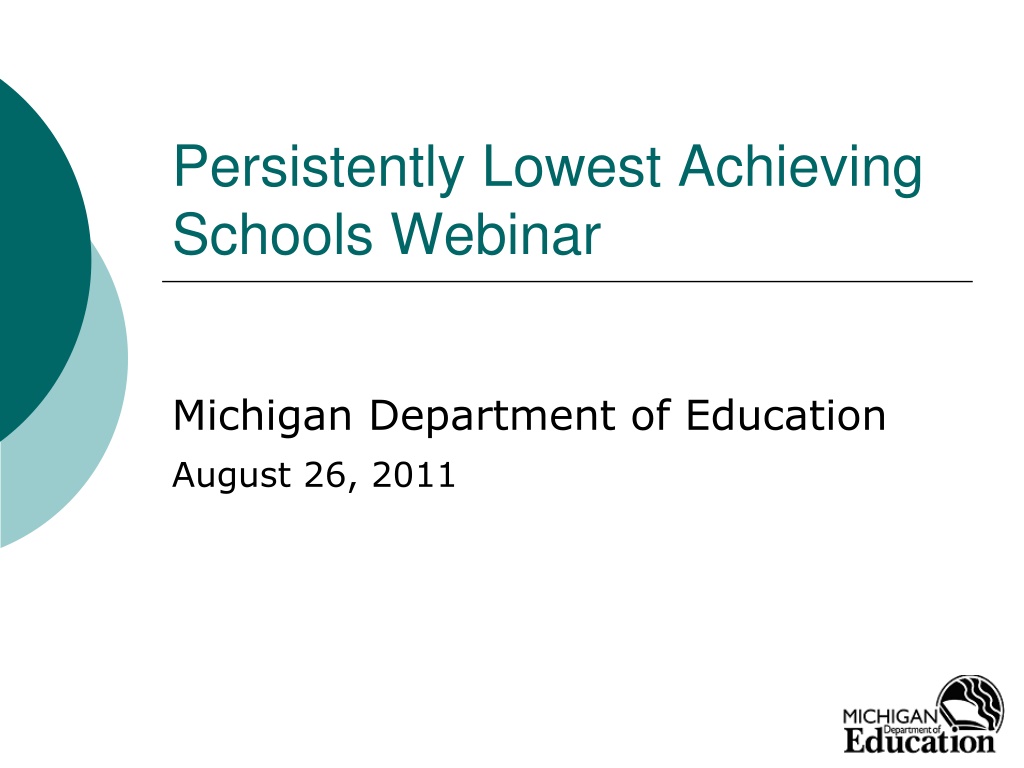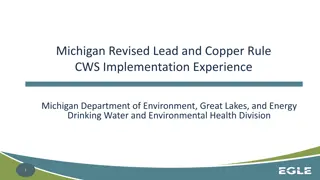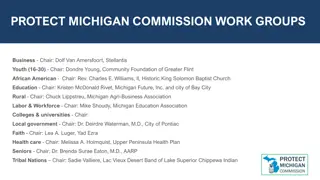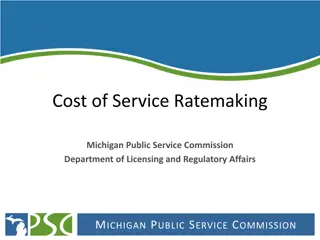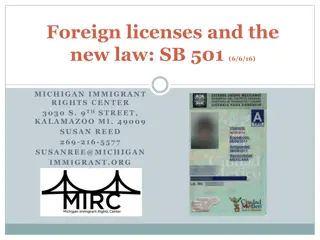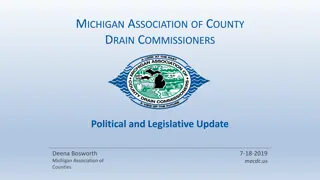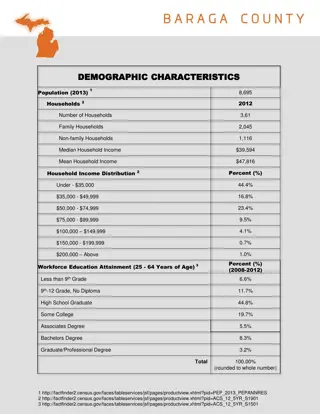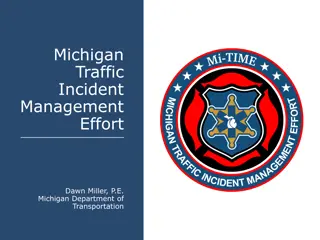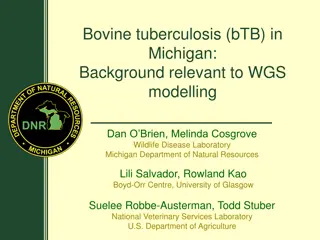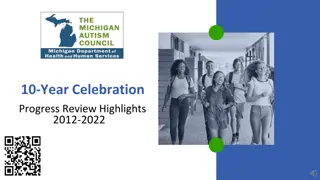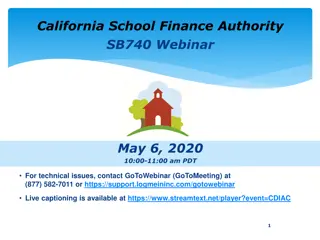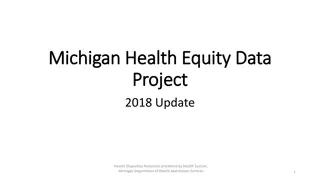Understanding Michigan's Persistently Lowest Achieving Schools Webinar
Explore the criteria and processes involved in identifying and supporting persistently lowest achieving schools in Michigan. Discover the state statutes, requirements, and timelines for these schools, including the development of redesign plans and potential modifications to collective bargaining agreements. Gain insights into the actions taken to improve performance and meet state standards.
Download Presentation

Please find below an Image/Link to download the presentation.
The content on the website is provided AS IS for your information and personal use only. It may not be sold, licensed, or shared on other websites without obtaining consent from the author. Download presentation by click this link. If you encounter any issues during the download, it is possible that the publisher has removed the file from their server.
E N D
Presentation Transcript
Persistently Lowest Achieving Schools Webinar Michigan Department of Education August 26, 2011
Persistently Lowest Achieving Schools Agenda Brief review of the state statute that is the basis for the state School Reform/Redesign Office (SRRO) Brief review of the state requirements for schools on the Persistently Lowest Achieving Schools (PLA) list Review of the metrics that lead to a school being placed on the PLA list Resources and talking points for staff and the media 2
Persistently Lowest Achieving Schools State Statute Review 3
Persistently Lowest Achieving Schools State law requires identification of lowest achieving schools by September 1 of each year beginning in 2010 List of Persistently Lowest Achieving Schools is developed following federal guidelines approved by the United States Department of Education as required in state law 4
Persistently Lowest Achieving Schools State Requirements and Timeline 5
Persistently Lowest Achieving Schools Schools on the list must submit a redesign plan to the state and implement the plan Plans must be approved by the state school reform/redesign officer (SRRO) Schools without approved plans or those not making progress under its plan are subject to further action 6
Persistently Lowest Achieving Schools Some elements of the collective bargaining agreements in PLA schools may be modified to implement the redesign plan HB 4628 recently amended the public employment relations Act to prohibit certain subjects from being collectively bargained 7
Persistently Lowest Achieving Schools Prohibited subjects of collective bargaining teacher placement or personnel decisions. employer s performance evaluation system discharge or discipline of an employee classroom observations decisions performance-based method of compensation parental notification of ineffective teachers 8
Persistently Lowest Achieving Schools Plans may take effect immediately, but no later than the beginning of the school year after approval Per statute, plans must use 1 of 4 intervention models Transformation Turnaround Restart Closure Plans must include any collective bargaining agreement amendments needed to implement the intervention models 9
Persistently Lowest Achieving Schools If the SRRO disapproves a plan, or if the school does not achieve satisfactory results, the SRRO will: Place the school into the State School Reform/Redesign District (SRRD) Impose one of the four approved intervention models Amend collective bargaining agreement to implement plan SRRO may appoint a chief executive officer (CEO) (for one school or multiple schools) 10
Persistently Lowest Achieving Schools SRRO must approve a redesign plan if it contains all of the required elements of the intervention If SRRO disapproves a redesign plan, the LEA may appeal the disapproval to the Superintendent of Public Instruction (SPI) SPI decision is final 11
Persistently Lowest Achieving Schools Communicating with staff, the local board and the local media 12
Persistently Lowest Achieving Schools Timeline August 26, 2011 Department notification September 8, 2011 1st technical assistance meeting- Lansing Center October 4, 2011 2nd technical assistance meeting-Plan review and revisions Lansing Center November 28, 2011 Deadline for submission of redesign plan December 7-9, 2011 MDE review of final redesign plan January 9, 2011 Approval, disapproval, or change February 6, 2011 Changes submitted January 9 thru Feb 7 Opportunity to appeal SRO disapproval Jan thru August 2012 Pre Implementation activities on approved plans September 1, 2012 MDE notifies identified school communities regarding schools on the 2012- 2013 PLA list 13
Persistently Lowest Achieving Schools What happens if the building does not make sufficient progress? The SRRO recommends that the school be placed in the School Reform/Redesign District (SRRD) Duties and powers of the SRRD are transferred to the Educational Achievement Authority: A statewide public school district Made up of those schools assigned to it by the SRRO or schools that are under a EM 14
Persistently Lowest Achieving Schools Opportunity for Technical Assistance September 8 and October 4, 2011 9:00 a.m. to 2:00 p.m. Banquet Rooms 1-4 Lansing Center Lansing, Michigan Plan to bring a team of 3-4 staff to assist with the development of the plan for turning around the school(s) in your district. 15
Persistently Lowest Achieving Schools Department staff will review the timeline, the four redesign models, the redesign template, and issues surrounding the use of existing state and federal funds, and answer your questions Please rvsp by September 1, 2011 with the total number attending from your district to Jill Baynes at: baynesj@michigan.gov 16
Persistently Lowest Achieving Schools Questions?? 17
Understanding the ranking metric Some of you may have questions about the metric used to identify the schools on the Persistently Lowest Achieving Schools list For those of you that don t have questions about the metric, we will look forward to seeing you on the 24th For those of you who would like to understand the metric in greater detail, we invite you to remain with us a bit longer for a review of the metrics 18
Two Tiers of Persistently Lowest Achieving (PLA) Schools Two tiers of schools Two pools Two lists Two sets of requirements Underlined items were items on which the State had some discretion August 26, 2011 19
Tier I Pool Defining the pool of schools from which the Tier I list is identified The Tier I pool consists of schools meeting all of the following criteria: At least 30 Full Academic Year students with scores on Mathematics in the most recent two years At least 30 Full Academic Year students with scores on Reading in the most recent two years Eligible to receive Title I funding Receiving Title I funding School is in a phase of School Improvement Identified for Improvement Corrective Action Restructuring 112 total schools are in the Tier I pool Note: Tier I is independent of EducationYES! August 26, 2011 20
Tier I List Identifying schools on the Tier I list Two paths to get onto the Tier I list Path 1 from the Tier I pool Calculate percentile ranks (explained later) School is on the Tier I list if the school percentile rank is less than 5 Path 2 from the Tier I pool School is on the Tier I list if it is a secondary school with a graduation rate less than 60% for three years running Results 9total schools on the Tier I list 5 from path 1 4 from path 2 August 26, 2011 21
Tier II Pool Defining the initial pool of schools from which the initial Tier II list is identified The initial Tier II pool consists of schools meeting all of the following criteria: At least 30 Full Academic Year students with scores on Mathematics in the most recent two years At least 30 Full Academic Year students with scores on Reading in the most recent two years Eligible for, but not receiving Title I funding Is a secondary school (serves at least one grade in the range 7-12) 560 total schools are in the Tier II pool Note: Tier II is independent of both AYP and EducationYES! August 26, 2011 22
Tier II List Tier II Identifying schools on the Tier II list Three paths to get onto the Tier II list Path 1 from the Tier II pool Calculate percentile ranks (explained later) School is on Tier II list if school percentile rank is less than 5 Path 2 from the Tier II pool School is on Tier II list if it is a secondary school with a graduation rate less than 60% for three years running Path 3 from the Tier I pool School is on Tier II list if it ranks lower than or equal to (on a statewide ranking of all schools) the highest ranked school that got onto the Tier II list through path 1 Results 89 total schools on the Tier II List 29 through path 1 0 through path 2 60 through path 3 August 26, 2011 23
Persistently Lowest Achieving Schools by Tier Tier I List 9 Tier II List 89 Total 98 August 26, 2011 24
Calculating Percentile Ranks Details and schematic in the next slide Incorporate both mathematics and reading Incorporate both achievement level and improvement rates, weighting achievement more heavily than improvement Level the playing field across High schools versus Elementary/Middle schools Reading versus Mathematics August 26, 2011 25
High School Two-Year Average Percent Proficient z-score 2/3 Reading HS Reading Percentile Rank HS Reading Index 4-year slope (improvement) z-score 1/3 (ranking on the average of all percentile ranks metric) High School Two-Year Average Percent Proficient Mathematics z-score 2/3 Average of all Assigned Percentile Ranks HS Math Percentile Rank HS Math Index Start with raw data Overall Percentile Rank 4-year slope (improvement) z-score 1/3 % proficient Elementary/Middle School Reading Two-Year Average Percent Proficient % improving minus % declining (MEAP) z-score 2/3 E/MS Reading Percentile Rank E/MS Reading Index % improvement trend slope (MME) Two-Year Average % Improving minus % Declining z-score 1/3 Elementary/Middle Two-Year Average Percent Proficient z-score 2/3 Mathematics School E/MS Math Percentile Rank E/MS Math Index Two-Year Average % Improving minus % Declining z-score 1/3 May 17, 2010 26
High School Two-Year Average Percent Proficient z-score 2/3 Reading HS Reading Percentile Rank Calculate z-scores HS Reading Index 4-year slope (improvement) z-score 1/3 Z-scores are a statistical method used to level the playing field between (ranking on the average of all percentile ranks metric) High School Two-Year Average Percent Proficient Mathematics z-score 2/3 Average of all Assigned Percentile Ranks ELA and Math HS Math Percentile Rank HS Math Index Overall Percentile Rank Elementary/Middle and High schools 4-year slope (improvement) z-score 1/3 Achievement and Improvement Elementary/Middle School Reading Two-Year Average Percent Proficient z-score 2/3 E/MS Reading Percentile Rank E/MS Reading Index Positive z-scores show how many standard deviations (SD) above the pool average the school is Two-Year Average % Improving minus % Declining z-score 1/3 Elementary/Middle Negative z-scores show how many standard deviations (SD) below the pool average the school is Two-Year Average Percent Proficient z-score 2/3 Mathematics School E/MS Math Percentile Rank E/MS Math Index Two-Year Average % Improving minus % Declining z-score 1/3 May 17, 2010 27
High School Two-Year Average Percent Proficient z-score 2/3 Reading HS Reading Percentile Rank HS Reading Score 4-year slope (improvement) z-score 1/3 (ranking on the average of all percentile ranks metric) High School Two-Year Average Percent Proficient Mathematics z-score 2/3 Average of all Assigned Percentile Ranks HS Math Percentile Rank HS Math Score Calculate a combined Proficiency/improvement score and percentile rank for each Overall Percentile Rank 4-year slope (improvement) z-score 1/3 Elementary/Middle Subject (ELA vs. math) School Reading Two-Year Average Percent Proficient z-score 2/3 Level of School (elementary/middle versus high school) E/MS Reading Percentile Rank E/MS Reading Score Two-Year Average % Improving minus % Declining z-score 1/3 Elementary/Middle Two-Year Average Percent Proficient z-score 2/3 Mathematics School E/MS Math Percentile Rank E/MS Math Score Two-Year Average % Improving minus % Declining z-score 1/3 May 17, 2010 28
Calculate average and overall percentile rank High School Two-Year Average Percent Proficient z-score 2/3 Reading HS Reading Percentile Rank HS Reading Score 4-year slope (improvement) z-score 1/3 (ranking on the average of all percentile ranks metric) High School Two-Year Average Percent Proficient Mathematics z-score 2/3 Average of all Assigned Percentile Ranks HS Math Percentile Rank HS Math Score Overall Percentile Rank 4-year slope (improvement) z-score 1/3 Elementary/Middle School Reading Two-Year Average Percent Proficient z-score 2/3 E/MS Reading Percentile Rank E/MS Reading Score Two-Year Average % Improving minus % Declining z-score 1/3 Elementary/Middle Two-Year Average Percent Proficient z-score 2/3 Mathematics School E/MS Math Percentile Rank E/MS Math Score Two-Year Average % Improving minus % Declining z-score 1/3 May 17, 2010 29
Examples Examples are shown for a high school and for an elementary/middle school in the following slides August 26, 2011 30
High School Not 2/3 Not applicable applicable Reading Not applicable Not applicable Not 1/3 Not applicable applicable (only 8.9474 percent of schools in pool had a lower average percentile rank) High School Not Mathematics 2/3 Not applicable applicable Average Percentile Rank = 11.7978 Overall Percentile Rank = 8.9474 Not applicable Not applicable Not 1/3 Not applicable applicable Elementary/Middle 0.9455 SD below the mean School Reading 67.0596 average percent proficient 2/3 Reading percentile rank = 10.4869 -0.5211 (composite) Average of 3.8021% more students improving than declining 0.2177 SD above the mean 1/3 Elementary/Middle 0.9917 SD below the mean 68.0829 average percent proficient 2/3 Mathematics School Mathematics percentile rank = 13.1086 -0.5786 (composite) Average of 7.0891% more students declining than improving 0.2476 SD above the mean 1/3 May 17, 2010 31
0.8408 SD below the mean High School 38.7700 average percent proficient 2/3 Reading Reading -0.7668 (composite) Percentile Rank = 10.0592 0.6909 SD below the mean Losing 1.48% proficiency per year 1/3 (only 6.1404% of schools in pool had a lower average percentile rank) 0.8822 SD below the mean High School 31.0599 average percent proficient Mathematics 2/3 Average Percentile Rank = 7.8403 Overall Percentile Rank = 6.1404 Mathematics Percentile rank = 5.6213 -0.9504 (composite) 1.0748 SD below the mean Losing 2.26% proficiency per year 1/3 Elementary/Middle School Reading Not 2/3 Not applicable applicable Not applicable Not applicable Not 1/3 Not applicable applicable Elementary/Middle Not 2/3 Not applicable Mathematics applicable School Not applicable Not applicable Not 1/3 Not applicable applicable May 17, 2010 32
Specific School Data You can see an individual school s data in the schematic format by clicking on August 26, 2011 33
PLA Statewide Ranking The Federal regulations require comparing schools from the Tier I and Tier II pools. However, the Tier I and Tier II pools are non- overlapping Therefore, a PLA ranking of schools was also calculated. Some schools did not receive a PLA ranking because they tested fewer than 30 students in Reading and/or Mathematics in School years 2008-09 and/or 2009-10. This PLA percentile ranking was calculated using the same methods as for the Tier I and Tier II pools. August 26, 2011 34
Creating the PLA Statewide list Start with all schools that tested at least 30 full academic year students in both reading and mathematics in the most recent two years Then, rank the schools top to bottom Each gray bar (to the left) represents a single school This is the PLA Statewide Ranking (in 2010-2011, used only to identify PLA schools). August 26, 2011
Creating the PLA Statewide List Your school might be anywhere on this statewide list. August 26, 2011
Federally Approved Requirements for Identify- ing Persistently Lowest Achieving Schools Therefore pools of schools that are eligible to become part of the Tier I list or Tier II list of PLA schools are subsets of the top to bottom list. August 26, 2011
Identifying the Tier I Pool Next, identify the subset of schools in the Tier I pool Schools in the Tier I pool meet all of the following conditions They receive Title I funding They are in corrective action, restructuring, or improvement (have not made AYP for at least two years in a row) Shown in pink This is the pool of schools from which the Tier I list is identified August 26, 2011
Creating the Tier I List Next, identify the lowest achieving 5% of the Tier I pool These are the schools in the Tier I list of PLA schools that fall under the responsibility of the State School Reform and Redesign Officer (SRRO) Shown in bright red Note also that any high school in the Tier I pool with a graduation rate of less than 60% for three years running also becomes part of the Tier I list (not shown in the schematic) August 26, 2011
Identifying the Tier II Pool Next, identify the subset of schools in the Tier II pool Schools in the Tier II pool meet all of the following conditions They are eligible to receive, but do not receive, Title I funding They are secondary schools (meaning they instruct students in any grade in the range 7- 12) Shown in light blue This is the pool of schools from which the initial Tier II list is identified August 26, 2011
Creating the Tier II List Next, identify the lowest performing 5% of schools in the Tier II pool This is the initial Tier II list of PLA schools. These schools are under the responsibility of the SRRO Shown in bright blue Note also that any high school in the Tier II pool with a graduation rate of less than 60% for three years running also becomes part of the Tier II list (not shown in the schematic) August 26, 2011
Creating the Tier II List o Finally, identify any schools from the Tier I pool that did not qualify for the Tier I list, but whose ranking was lower than the highest ranking school in the initial Tier II list o These are schools in pink lower than the highest school in bright blue August 26, 2011
Creating the Tier II List o Finally, identify any schools from the Tier I pool that did not qualify for the Tier I list, but whose ranking was lower than the highest ranking school in the initial Tier II list o These are schools in pink lower than the highest school in bright blue o Switch these schools to bright blue o This is the rest of the Tier II list of PLA schools. These schools are also under the responsibility of the SRRO August 26, 2011
Other Low Achieving Schools o Note that because of the way the Tier I pool and Tier II pool are defined in Federal guidelines, it is possible for a low achieving school to not be on either the Tier I list or Tier II list of PLA Schools o These are the schools in gray whose performance is lower than the highest school in bright red or bright blue. o These schools are not under the responsibility of the SRRO
How Can a Low Achieving School Not Show Up on the PLA Schools List? Based on federally approved requirements, this depends on the school s AYP status, whether the school receives or is eligible to receive Title I funding, and whether the school is a secondary school: School AYP Status School Title I Funding Category Not in Corrective Action, Restructuring, or Improvement (Making AYP) In Corrective Action, Restructuring, or Improvement (Not Making AYP) Receives Title I funding Not eligible for any pool Eligible for the Tier I Pool Is a secondary school that is eligible for but does not receive Title I funding Eligible for the Tier II Pool Eligible for the Tier II Pool Is not a secondary school, and is eligible for but does not receive Title I funding Not eligible for any pool Not eligible for any pool Is not eligible to receive Title I funding Not eligible for any pool Not eligible for any pool Some low achieving schools may not be eligible to be considered a PLA School because of the way the pools were defined in federal requirements August 26, 2011
Top to Bottom Ranking MDE will publish a separate Top to Bottom Ranking of all schools, using our preferred methodology. To view this ranking, go to http://www.michigan.gov/mde/0,46 15,7-140-37818_56562---,00.html The PLA statewide ranking is produced only in order to implement the federal rules for identifying PLA schools. August 26, 2011 46
Contact Information For Persi Deborah Clemmons State School Reform Office clemmonsd@michigan.gov Jill Baynes Department Analyst 517-335-2741 47 August 26, 2011
Contact Information For Questions Regarding Data or Metrics: Joseph Martineau, Ph.D. Executive Director, Bureau of Assessment and Accountability martineauj@michigan.gov Venessa Keesler, Ph.D. Manager, Evaluation, Research and Accountability keeslerv@michigan.gov 517-373-1342 48 August 26, 2011
